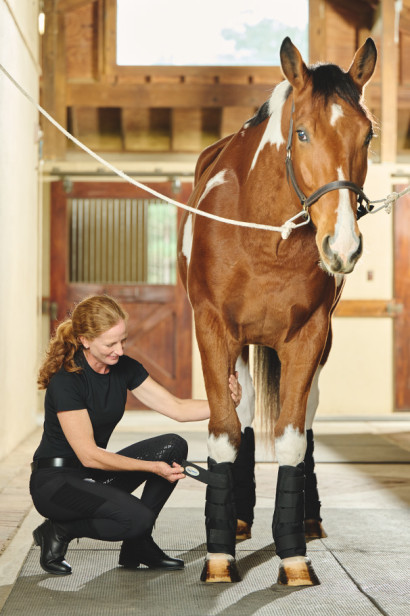The Power of Equine Therapy for Anxiety, PTSD, and Psychological Healing
The Power of Equine Therapy for Anxiety, PTSD, and Psychological Healing
Blog Article
Examining the Efficiency of Laser Therapy in Horse Treatment for Injury Rehab
The evaluation of laser treatment's performance in equine injury rehab hinges on numerous elements, consisting of recovery time, discomfort reduction, and cells regrowth. Veterinarians frequently observe superior outcomes with laser treatment contrasted to conventional approaches, positioning it as a crucial component in equine treatment.
Comprehending Laser Therapy
Laser treatment has actually ended up being a critical device in vet medication, especially in the treatment of equine problems. Recognized for its non-invasive nature and efficacy, laser treatment entails the application of specific wavelengths of light to boost tissue repair service and reduce swelling. This restorative modality is progressively favored for its capability to increase the healing process in equines experiencing from a range of bone and joint injuries and persistent problems.
The primary system behind laser treatment is its capability to improve cellular features. Furthermore, laser treatment advertises vasodilation, enhancing blood circulation and oxygen delivery to damaged cells, therefore expediting recuperation.
In equine medicine, laser treatment is specifically beneficial for problems such as tendonitis, osteo arthritis, and injury healing. The method is admired for its pain-relieving properties, permitting steeds to reclaim flexibility and feature more swiftly. Veterinarians also value its marginal negative effects contrasted to other therapy modalities, making it a reputable and secure choice for equine treatment.

How Laser Treatment Functions

Upon absorption, these photons set off a collection of biochemical adjustments, improving mitochondrial feature and bring about raised adenosine triphosphate (ATP) production. This surge in ATP increases mobile metabolism, promoting cells repair work and regrowth. Additionally, laser treatment modulates inflammatory feedbacks by influencing cytokine degrees and minimizing oxidative stress, thereby reducing pain and swelling.
An additional considerable element of laser therapy is its duty in enhancing microcirculation. The therapy advertises vasodilation, boosting blood circulation and oxygen shipment to damaged tissues (Equine Therapy). This facilitates the removal of mobile debris and sustains the expansion of fibroblasts and collagen synthesis, critical for injury recovery
Professional Evidence
The efficacy of laser therapy in equine therapy has actually been substantiated via various professional research studies, showcasing its therapeutic possible across an array of problems. Numerous controlled trials and observational studies have actually documented significant renovations in cells fixing, pain reduction, and general recovery timelines. For circumstances, a research study performed by Turner et al. (2012) demonstrated that steeds treated with low-level laser treatment (LLLT) for tendon injuries displayed sped up recovery compared to those obtaining traditional treatments. The study highlighted a significant decrease in swelling and improved collagen development.
In a check similar way, study by Johnson and coworkers (2015) concentrated on equine muscle mass injuries, disclosing that laser treatment significantly sped up muscle mass fiber regeneration and decreased muscle rigidity. Clinical evaluations have revealed that laser therapy can relieve persistent problems such as osteoarthritis.
Veterinarian Insights

Veterinarians additionally value the versatility of laser treatment. It can be used for a large range of problems, from superficial injuries to much deeper bone and joint injuries. Dr. Emily Brown highlights its energy in treating problems like tendonitis and osteo arthritis, where standard you can try this out therapies typically fail. She points out that laser therapy can be tailored to the particular demands of each horse, making sure ideal results.
Additionally, vets value the capability to incorporate laser therapy with various other therapy modalities. This multimodal approach can improve overall treatment effectiveness, giving a comprehensive remedy for equine rehabilitation. Such recommendations from seasoned specialists underscore the growing approval and application of laser treatment in equine medication.
Practical Factors To Consider
A key element of carrying out laser therapy in equine treatment entails comprehending the functional factors to consider that guarantee its effectiveness and safety. It is vital to select the suitable laser tool, as numerous kinds vary in wavelength, power, and infiltration depth. Vets must be fluent in these specifications to customize therapy protocols efficiently to each injury type
Additionally, the frequency and period of laser therapy sessions require mindful preparation to make the most of therapeutic benefits while lessening any kind of prospective unfavorable impacts. Constant surveillance of the equine's action to therapy can assist essential adjustments in the treatment program. Establishing a safe and regulated environment throughout therapies is also important to protect against unintentional exposure to laser exhausts, which could hurt both the horse and the handler.
Training and accreditation of workers providing laser therapy are extremely important to guarantee look at these guys proper technique and to promote safety requirements. Additionally, maintaining precise records of each session, consisting of laser settings and observed outcomes, is essential for assessing the overall performance of the treatment and for making data-driven choices.
Verdict
Laser therapy has become a reliable modality in equine injury recovery, providing considerable advantages in healing time, pain alleviation, and cells recovery. Scientific studies underscore substantial enhancements in problems such as tendonitis and osteo arthritis, connected to improved mobile function and enhanced ATP production. Vet observations prove these searchings for, highlighting exceptional end results compared to typical therapies. For optimal results, constant surveillance and personalized therapy methods remain crucial in leveraging the full potential of laser treatment in equine treatment.
Report this page